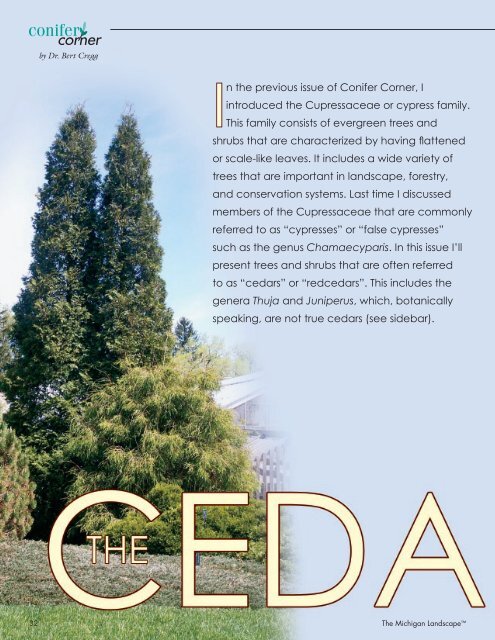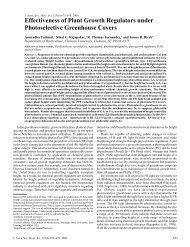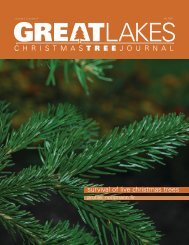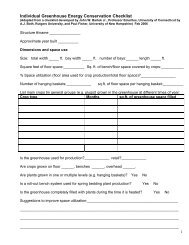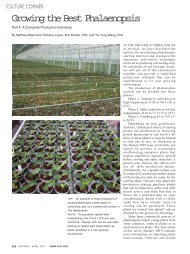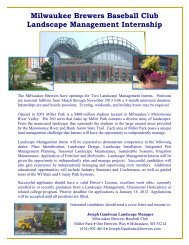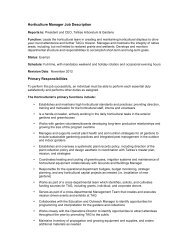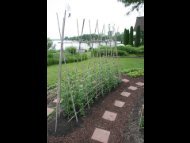In the previous issue of Conifer Corner, I introduced the ...
In the previous issue of Conifer Corner, I introduced the ...
In the previous issue of Conifer Corner, I introduced the ...
You also want an ePaper? Increase the reach of your titles
YUMPU automatically turns print PDFs into web optimized ePapers that Google loves.
y Dr. Bert Cregg<strong>In</strong> <strong>the</strong> <strong>previous</strong> <strong>issue</strong> <strong>of</strong> <strong>Conifer</strong> <strong>Corner</strong>, I<strong>introduced</strong> <strong>the</strong> Cupressaceae or cypress family.This family consists <strong>of</strong> evergreen trees andshrubs that are characterized by having flattenedor scale-like leaves. It includes a wide variety <strong>of</strong>trees that are important in landscape, forestry,and conservation systems. Last time I discussedmembers <strong>of</strong> <strong>the</strong> Cupressaceae that are commonlyreferred to as “cypresses” or “false cypresses”such as <strong>the</strong> genus Chamaecyparis. <strong>In</strong> this <strong>issue</strong> I’llpresent trees and shrubs that are <strong>of</strong>ten referredto as “cedars” or “redcedars”. This includes <strong>the</strong>genera Thuja and Juniperus, which, botanicallyspeaking, are not true cedars (see sidebar).32 The Michigan Landscape
Thuja: One <strong>of</strong> <strong>the</strong> remnants <strong>of</strong> myforestry training is that I still referto Thuja plicata as Western redcedarand Thuja occidentalis as Nor<strong>the</strong>rnwhite-cedar, although I’ve been aroundhorticulturists long enough that I’vebecome conditioned to using arborvitaeas a common name. <strong>In</strong>terestingly, <strong>the</strong>common name arborvitae (meaning “tree<strong>of</strong> life”) comes from <strong>the</strong> fact that NativeAmericans taught early French explorersto use foliage from Thuja occidentalis toprevent scurvy. By almost any measure,<strong>the</strong> number <strong>of</strong> arborvitae cultivars in <strong>the</strong>nursery trade is staggering. The American<strong>Conifer</strong> Society Database lists over 150cultivars <strong>of</strong> Thuja occidentalis and MichaelDirr Lists 40 cultivars <strong>of</strong> Thuja plicata.The vast number <strong>of</strong> cultivated varieties isa testament to great variability with <strong>the</strong>two species as well as <strong>the</strong>ir relative ease<strong>of</strong> propagation by rooted cuttings. <strong>In</strong> <strong>the</strong>trade arborvitae are <strong>of</strong>ten distinguishedsimply by cultivar and frequently littleattention is paid to whe<strong>the</strong>r a cultivar isT. plicata or T. occidentalis although Dirrsuggests that T. plicata is superior from anornamental standpoint.September/October 2004Thuja plicata: <strong>In</strong> its native rangewestern redcedar is a massive tree. TheNational Champion western redcedaris over 150' tall and nearly 20' indiameter. This species is highly valuedfor its decay resistant lumber and iswidely used for shakes and shingles. Thetree is referred to as <strong>the</strong> cornerstone <strong>of</strong>Native American culture in <strong>the</strong> PacificNorthwest. Native Americans used <strong>the</strong>trunks <strong>of</strong> western redcedar for dugoutcanoes and pounded <strong>the</strong> tree’sstringy bark smooth for clothing andeven diapers for <strong>the</strong>ir infants. Whiletoday most parents prefer Pampersto pounding bark, <strong>the</strong>re are manyT. plicata cultivars that are used inlandscaping.‘Elegantissima’: This cultivar is ratedas an intermediate grower by <strong>the</strong>American Confer Society (6"-12"per year). Chub notes: “This is anupright form that is doing very well at<strong>the</strong> Heartland Collection in Clinton,Iowa.” (Zone 5)‘Virescens’: Ano<strong>the</strong>r T. plicata withan upright habit; dark green tree withan elegant form (Variously listed asZone 4 or 5)‘Excelsa’: Ano<strong>the</strong>r <strong>of</strong> Chub’s favoritesthat is doing well at <strong>the</strong> HeartlandCollection (Zone 5)Thuja occidentalis: Easternarborvitae or nor<strong>the</strong>rn white-cedaris <strong>the</strong> eastern cousin <strong>of</strong> T. plicata.The main range <strong>of</strong> nor<strong>the</strong>rn whitecedarextends through <strong>the</strong> sou<strong>the</strong>rnpart <strong>of</strong> <strong>the</strong> eastern half <strong>of</strong> Canadaand <strong>the</strong> adjacent nor<strong>the</strong>rn part <strong>of</strong><strong>the</strong> United States. <strong>In</strong> Michigan thisspecies occurs throughout Michigan’sUpper Peninsula, in <strong>the</strong> nor<strong>the</strong>rn half<strong>of</strong> <strong>the</strong> Lower Peninsula, and along <strong>the</strong>Lake Michigan shore. As mentioned<strong>previous</strong>ly, this species includes a widearray <strong>of</strong> cultivars that range in sizefrom dwarf conifers to large trees andspan <strong>the</strong> range <strong>of</strong> forms from creepingto columnar. A note <strong>of</strong> caution, manypopular globe forms <strong>of</strong> arborvitae suchas ‘Golden Globe’ and ‘Rheingold’ areattractive landscape plants when youngbut <strong>of</strong>ten have trouble withstandingsnow-loads as <strong>the</strong>y get larger. Many <strong>of</strong><strong>the</strong> upright forms will hold up betterthrough years <strong>of</strong> Michigan winters.‘Degroots Spire’: This columnarform can be planted as a singlespecimen or used in narrow situationsfor screening. (Zone 4)‘Smaragd’: The trade name is <strong>of</strong>tenlisted as ‘Emerald Green’. This isa dark green, upright to fastigateform. Chub notes: “This is <strong>the</strong> onlyarborvitae to crack my list <strong>of</strong> 25favorite conifers.” (Zone 4)‘Hetz Wintergreen’: Conical,narrow, upright, robust growing, withcompact bright green foliage; tendsto grow with a strong central leaderwithout special training; excellentyear-round screen (Zone 3)‘Sunkist’: Striking bright yellow togolden; fast growing, dense, broad,conical plant; one <strong>of</strong> <strong>the</strong> best in thiscolor class; Chub notes: “It’s a dandy.Train to a single leader.” (Zone 3)‘Holmstrup’: Upright, intermediategrower (6"–12" per year); mediumgreen color; Chub notes: “Needto keep this as a single leader whenyoung. If you let it do it’s own thing,you’ll have trouble with heavy, wetsnows.” (Zone 4)‘Recurva Nana’: Dark green witha mounding form; Chub notes:“One <strong>of</strong> <strong>the</strong> best. Less problem withsnow loads than many <strong>of</strong> <strong>the</strong> globeforms.”(Zone 3)Juniperus: This genus includesabout 50 species, 11 <strong>of</strong> which arenative to North America includingEastern redcedar (Juniperusvirginiana) and Rocky Mountainjuniper (J. scopulorum). Both speciesare commonly grown in conservationnurseries and <strong>the</strong>y are important treesfor conservation forestry plantingssuch as windbreaks and living snowfences. Eastern redcedar wood is highlyvalued for its scent and decay resistance.And, <strong>of</strong> course, juniper berries areresponsible for <strong>the</strong> characteristic flavor<strong>of</strong> gin. Although named cultivars <strong>of</strong> J.virginiana and J. scopulorum have beendeveloped, most <strong>of</strong> <strong>the</strong> Junipers in <strong>the</strong>landscape trade are exotics.Juniperus squamata‘Prostrata’: Prostrate, groundcoveringform with blue foliage that33
eventually mounds in <strong>the</strong> center;Chub notes: “This has proven one <strong>of</strong><strong>the</strong> best prostrate forms <strong>of</strong> junipers for<strong>the</strong> Midwest because <strong>of</strong> its resistanceto Phomopsis tip blight.” (Zone 4)Juniperus horizontalis: Thisspecies includes nearly 60 cultivars butmany begin to look shabby with agedue to Phomopsis blight.‘Blue Rug’: This is a nice blue-green,ground-hugging juniper for spillingover rocks or as a perimeter plant.(Zone 3)‘Mo<strong>the</strong>r Lode’: Bright yellow groundhugging form; excellent groundcover;relatively low-maintenance onceestablished (Zone 3)‘Venusta’: Striking prostrate form(Zone 5)Juniperus chinensis: Often fastgrowers; Chub notes: “Be careful withchinensis, <strong>the</strong>y <strong>of</strong>ten get too big andcan overwhelm a landscape.”‘Saybrook Gold’: Gold color<strong>of</strong> <strong>the</strong> new growth is set againsta background <strong>of</strong> green and goldvariegation on older needles; slightorange cast to <strong>the</strong> winter color;(Zone 4)‘Robusta Green’: Versatile anddurable landscape plant for accent,windbreak or screen for narrowspaces; irregular columnar form;(Zone 4)Juniperus communis‘Effusa’: A spreading juniper withshiny foliage that grows 15"–18" tall;(Zone 3)‘Compressa’: Very narrow uprightform; slow growing (1"–6" year); agood choice for rock gardens; (Zone4)Juniperus sabina‘Calgary Carpet’: Compact,spreading evergreen with attractives<strong>of</strong>t green foliage; excellent lowgrowingaccent shrub; (Zone 3)‘Skandia’: spreading, denselybranched ground cover useful forborder or rock garden accent; verydurable in <strong>the</strong> landscape; holds itsbright green color well throughwinter (Zone 3)True Cedars. Although many members<strong>of</strong> <strong>the</strong> family Cupressaceae are commonlyreferred to as cedars, botanically speakingnone <strong>of</strong> <strong>the</strong>m can truly call <strong>the</strong>mselvescedars. True cedars (genus Cedrus) areneedled conifers that are actually members<strong>of</strong> <strong>the</strong> pinaceae family. Cedrus species arecharacterized by needles borne on shortshoots in tufts <strong>of</strong> 20–30, much like larches.The genus includes four species: deodarcedar, which is a popular ornamental inEurope and milder parts <strong>of</strong> <strong>the</strong> US suchas <strong>the</strong> Pacific Northwest; Atlas cedar(Cedrus atlantica), Cypress cedar (Cedrusbrevifolia) and Cedar <strong>of</strong> Lebanon (Cedruslibani). Cedars are large stately treesand <strong>the</strong>ir foliage gives <strong>the</strong>m a uniquecharacteristic. Unfortunately, cold wintertemperatures limit <strong>the</strong> use <strong>of</strong> true cedarsin Michigan. A subspecies <strong>of</strong> Cedruslibani (ssp. stenocoma) is hardy to zone 5and <strong>the</strong>re is a wonderful, large specimenat Hidden Lake Gardens in Tipton,Michigan.Thuja occidentalis ‘Degroots Spire’Justin “Chub” Harper is widelyknown as one <strong>of</strong> <strong>the</strong> leading experts ongarden conifers in <strong>the</strong> United States. TheHarper Collection <strong>of</strong> Dwarf and Rare<strong>Conifer</strong>s at MSU’s Hidden Lake Gardensis nationally recognized. Each “<strong>Conifer</strong><strong>Corner</strong>” includes Chub’s notes on hisfavorite (and not so favorite) conifers.34 The Michigan Landscape


